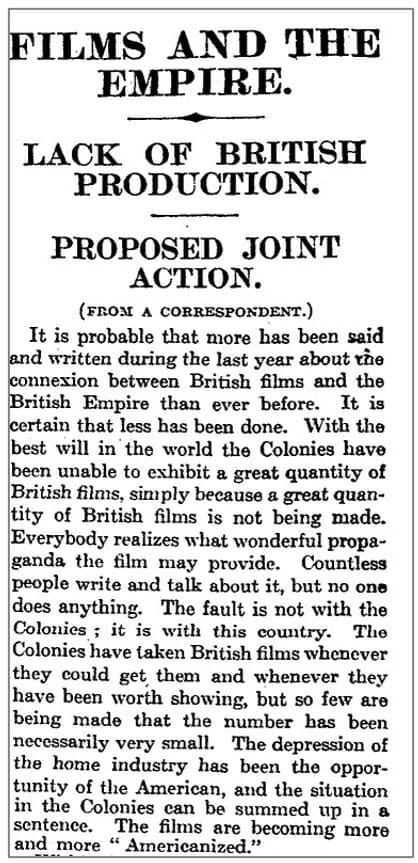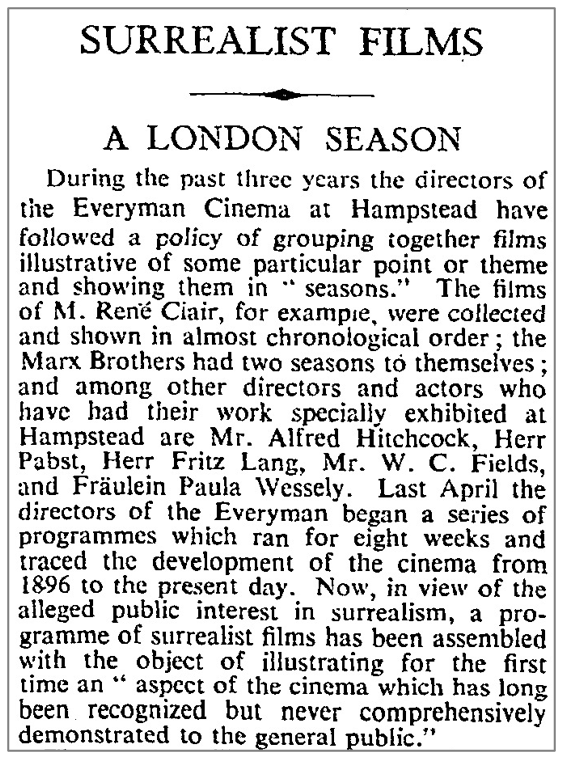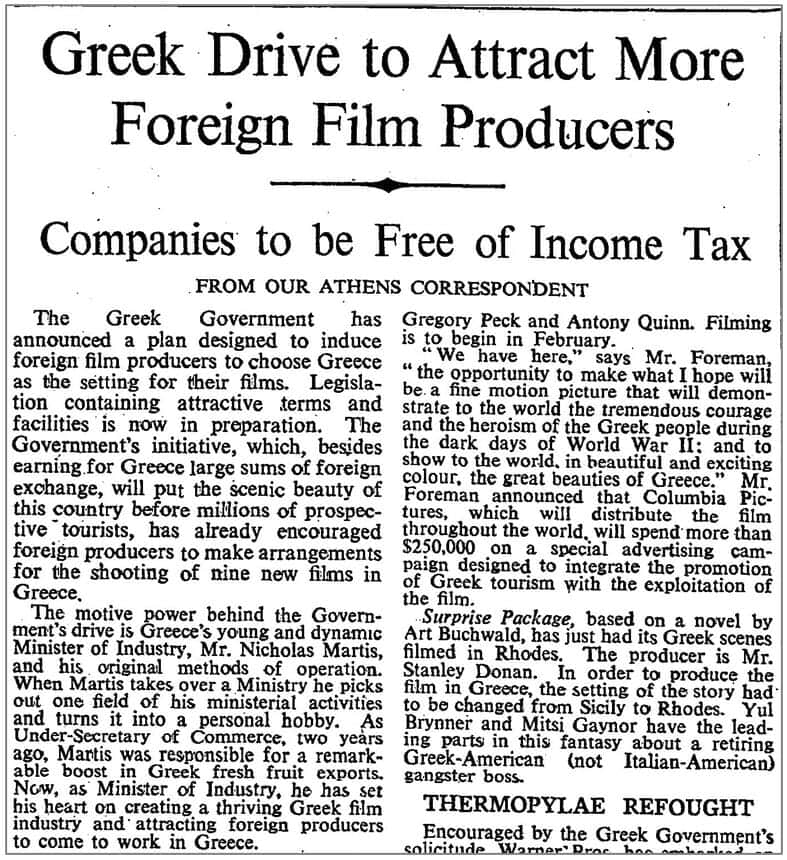│By Ava Nichols, Senior Gale Ambassador at the University of Aberdeen│
The film industry has taken great steps and developed in numerous ways since its creation in the nineteenth century. Using Gale Primary Sources collections, I decided to explore how the discussion of film in newspapers – be that promoting or reviewing individual films, or analysis of the film industry more generally – has evolved throughout the twentieth and twenty-first centuries. I decided to focus on The Times Digital Archive because selecting one publication as a controlled variable meant I was better able to examine the developing discussions of film and how it changed over time.
1920s – Films, Empire and Political Influence
In an article from 1926, a correspondent at the Times feared that a lack of films being produced in Britain created the opportunity for ‘American pictures [to] dominate British film screens.’ Furthermore, the author claims that ‘[e]verybody realizes what wonderful propaganda the film may provide’. Thus, this primary source shows us that, even in the early days of cinema, people understood that, as literature and newspaper publications had before, film had the ability to spread information, influence and educate. And consequently that film could play a role in politics and international relations such as diplomacy and empire.

Although the 1926 article suggests that there was a desire to limit the content on screens, an article from 1937 (below) emphasises the growing ‘public interest in surrealism’. The author highlights that surrealism is an ‘aspect of the cinema which has long been recognized but never comprehensively demonstrated to the general public.’ By documenting the public interest in surrealism, The Times conveys the rising popularity of different film genres and storytelling styles.

1950s – Spotting the Potential of Film to Boost a National Economy
In relation to the role film could play in international politics, as public interest in film increased, government officials began recognising the benefits of the film industry to national issues, government and the economy. For example, a Times article from 1959 quotes Greece’s Minister of Industry, Nicholas Martis, saying, ‘the Greek Government believes that Greece can develop into a great centre of international motion picture activity and we are determined to assist in this effort in every possible way’. What’s more, the increase of film production in Greece offered the opportunity to ‘put the scenic beauty of [the] country before millions of prospective tourists’.
For more on Columbia Pictures’ ‘special advertising campaign designed to integrate the promotion of Greek tourism with the exploitation of the film’, see the article below:

1980s – Battle of the Screens Initiated
In the last decades of the twentieth century, advances in technology and a reduction in costs put television sets in every sitting room. As a result, films were increasingly viewed on small rather than large screens. This proved to be controversial. In an article from 1980, David Robinson expresses his disappointment in the release of the film, The Long Good Friday, through television instead of movie theatres. Robinson states that although television offers ‘a much wider audience than the theatrical cinema’, he believes that television showing ‘devalues a film and reduces its impact. Moreover, a film denied theatrical showing in its home territory is instantly less attractive in the eyes of potential foreign markets.’ This article is an early example of the battle of the screens: television versus cinemas.

1980s – Growth in Advertising and Merchandising
Using The Times Digital Archive to research the release of popular films in the 1980s, I discovered an article by Geoff Brown in which the film critic emphasises the impact of advertising campaigns for Gremlins and Ghostbusters. Brown states that these films had ‘carefully orchestrated promotion campaigns, not to mention spin-off merchandise.’ Months before the completion of Gremlins, licensed merchandisers were supplying ‘toys, watches, video games, beach towels, lunch boxes and greetings cards’.
Regarding the promotion of Ghostbusters, ‘in newspapers and television commercial spots, there appeared an unidentified logo, featuring a harried-looking ghost poking out of a red circle’ with the slogan ‘Coming to Save the World this Summer’. This exemplifies the development of film promotional campaigns in advance of their release in theatres, which increased audience numbers and boosted box office profits.
2000s – A World ‘Where TV and Video Flow Across the Internet’
Long before the relatively recent creation of streaming services, video and DVD rentals provided the opportunity to watch films and television shows without needing to buy them. An advert in the Times from 2005 promotes a ‘Screen Select’ DVD rental subscription service by offering a free DVD to new subscribers. In addition to highlighting the promotional campaign, this advert emphasises the improving accessibility of films in the twenty-first century, with new methods and new purchasing options emerging for viewers to consume films.
!["Multiple Display Advertising Items." Times, 15 Apr. 2005, p. [44]. The Times Digital Archive](https://review.gale.com/wp-content/uploads/2023/09/Free-DVD-799x1024.jpg)
Similarly to David Robinson’s early contribution to the television versus cinema screens debate, back in 1980, in 1997, Nigel Powell predicted the future of streaming services. In this article, Powell writes ‘we could be moving towards a world where TV and video flow across the Internet as easily as Web pages currently do.’ Of course, this prediction has become a reality! This is exemplified in an article from 2015 which lists the various streaming services ‘available on any internet-connected device.’ This article states that ‘[t]he traditional TV providers are under siege from a new generation of video streaming services’, which provide ‘access to more than 100 million hours of TV, documentaries and feature films’.
2000s – Please, Please Don’t Look at it on a Phone
And of course, the availability of films on the internet has also led to the latest stage in the battle of the screens, as many people now watch films on a phone. In a comparatively recent article from 2019, Will Pavia and Matthew Moore emphasise the rise of streaming platforms and their impact on both cinema chains and the viewing experience. With this increasing use of streaming services, ‘Netflix allows subscribers to watch content on a range of devices but has said that 70 per cent of viewing still takes place on televisions, rather than phones, tablets or PCs.’ However, it is arguable that by making films and television series more accessible via the internet and a monthly subscription fee, audiences are less likely to purchase cinema tickets.
Although Pavia and Moore emphasise that cinema chains ‘view Netflix and Amazon Prime Video’s expansion into film as an existential threat’, Director Martin Scorsese continues to urge audiences to watch his films on larger screens, saying, ‘I would suggest, if you ever want to see one of my pictures, or most films, please, please don’t look at it on a phone’. By highlighting Scorsese’s preference for larger screens and movie theatres, Pavia and Moore draw attention to the significance of preserving cinema screens to allow viewers to continue enjoying films the way they were intended to be watched.

Varied Views and Interpretations of this Fascinating Cultural Medium
With the help of Gale’s Advance Search tools, I’ve examined various primary sources from The Times Digital Archive which examine film. I was able to make my search more specific with key terms, dates and document types. I’ve really enjoyed travelling through the twentieth and twenty-first century newspaper articles, to see how this archive covered the film industry, and the fascinating views and interpretations of this key cultural medium that have been expressed over the decades, including how it can impact politics.
If you enjoyed reading about film through the decades, check out:
- Horror and Censorship Alfred Hitchcock’s ‘Art of the Cinema’
- From Grimm to Gothic and Everything In Between: The Evolution of the Horror Genre
- From Archive to Master’s Thesis – Linguistic Analysis of Nineteenth-Century Theatre Reviews in The Times
- Understanding the Climax of HBO’s Mini-Series “Chernobyl” with Gale Primary Sources
- The Phantom of Popularity
- Ava’s previous blog post: A Reflection on the Reign of Queen Elizabeth II: The Modernisation of the Monarchy
Blog post cover image citation: A montage of images from this article and The Times Digital Archive.

